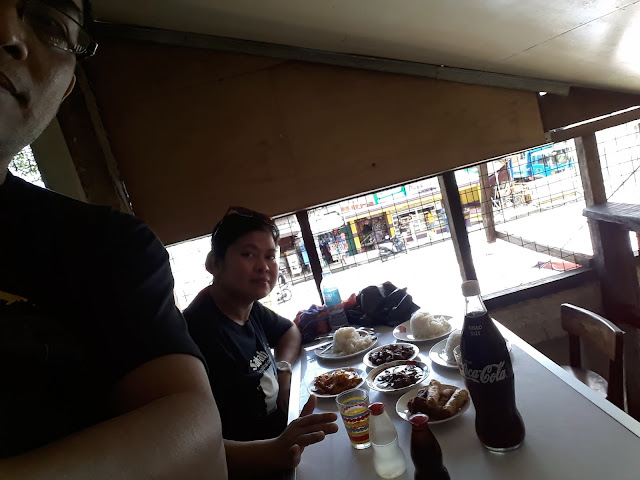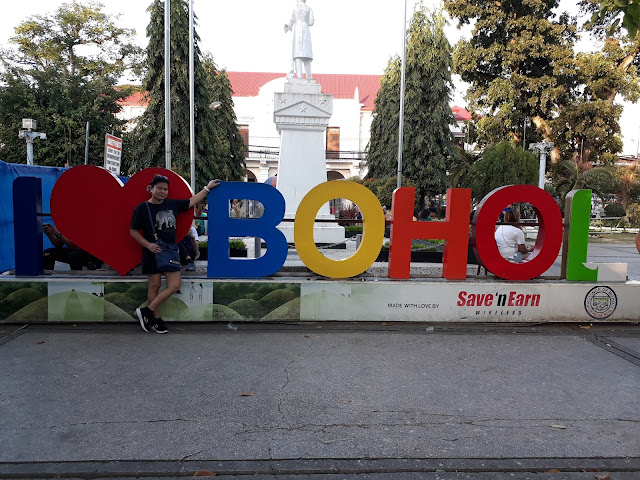February 22-26, 2019
Mabuhay!

This is a photo and video journal of our travel to the magnificent province of Bohol featuring day 2 of our travel itinerary - visit Tagbilaran City, the city of peace and friendship.
Interesting historic old buildings.
I'm really interested & fond of old historical buildings. Whenever I spotted one, I don't hesitate to capture it with my camera. Anywhere you look around Tagbilaran City, you'll find residential & commercial buildings that are made of wood from the '50s to the '70s era which withstood the passing of time.
Lunchtime in Cogon Market
 |
| A good meal is always spiced up with local chilis. |
 |
| Crunchy lumpiang shanghai which you can dip in vinegar. |
 |
| This is a very famous meal in the Philippines: pork blood stew, locally known as "dinuguan." |
 |
| Cooked bamboo shoots |
 |
| A simple rice meal for lunch in a local canteen. |
Roaming around the city aboard a minibus
Tagbilaran Church
At the public park
 |
| The monument of Dr. Jose P. Rizal, a Philippine national hero. |
Tagbilaran's old city hall |
| American colonial architecture is the motif of the old provincial hall. |
 |
| Floral design corbel |
 |
| Board and batten design wooden door |
Eating street food
Tokneneng or tukneneng is a tempura-like Filipino street food made by deep-frying orange batter-covered hard-boiled duck eggs. A popular variation of tukneneng is kwek kwek. The main difference between the two lies in the egg that is used. Kwek kwek is traditionally made with quail eggs coated in an orange batter made from mixing annatto powder, flour, and water, while tukneneng is made with duck eggs. Due to their similarities, the two are often confused with some people calling tukneneng "kwek kwek" and vice versa. In order to differentiate the two, "kwek kweks" are always smaller than "tuknenengs". They are often sold by street food vendors around busy areas and are usually sold alongside fishballs, squid balls, and kikiam. It is often coupled with the drink called gulaman.
Both are usually served with either a spiced vinegar-based dip, or a thick sweetened sauce.
The name "tukneneng" originated from the 1978 Pinoy komiks series Batute, illustrated by Vic Geronimo and created by Rene Villaroman. In the main character Batute's language, tukneneng means 'egg'.
Excerpt from Wikipedia: https://en.wikipedia.org/wiki/Tokneneng
 |
| The biggest variation of this street food from Visayas or Mindanao island from that of Luzon is the use of vegetable condiments. Visayas & Mindanao islands put seaweed whereas Luzon island put chopped cucumber. |
Interesting Old houses on the other block |
| This old house highlights horizontal wood slat walls, protruding bay windows, media agua eaves commonly known as a roof canopy, and vent grills. |
 |
| This house highlights tongue & groove ceiling eaves with decorative vents, horizontal wood slats wall and multi-colored glass windows. |
 |
| An interesting feature of this house is the decorative fascia of the media agua |
 |
| This mansion features facade symmetry, capiz shell on wooden frame windows, wood slat walls & hip roof. |
At the city's fish port |
| For us who came from the plain lands of Luzon island, we are really enchanted to see & smell the ambiance of the sea. |
 |
| At the fish port, this is where the city's local fish trade is taking place. |
Bus Ride to Tobigon Port
Breakfast at Tobigon Market |
| Suman-sticky rice wrapped in banana leaves. There are a lot of delicious variations of this famous Philippine delicacy across the country. |
 |
| Bitter gourd |
 |
| String beans |
Going back to Cebu |
| Waiting area at Tubigon Port |
 |
| Our tickets |
 |
| Souvenir picture before boarding |
Arrival at Pier 3 Cebu City























































































No comments:
Post a Comment